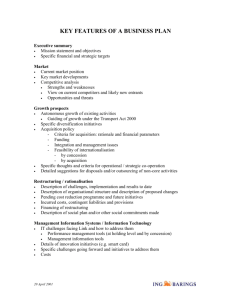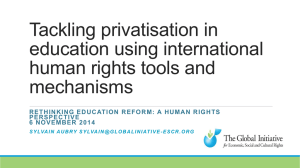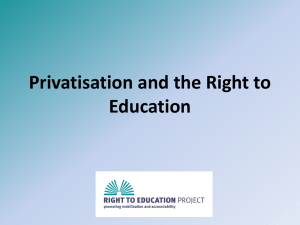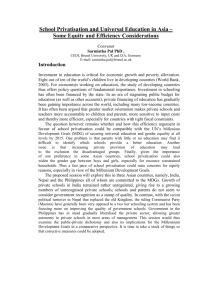PRIVATISATION: THE SINGAPORE PERSPECTIVE
advertisement
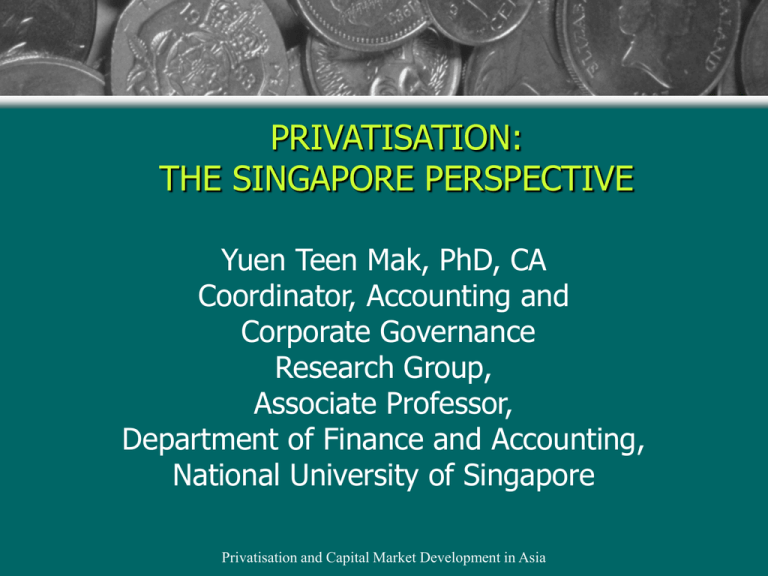
PRIVATISATION: THE SINGAPORE PERSPECTIVE Yuen Teen Mak, PhD, CA Coordinator, Accounting and Corporate Governance Research Group, Associate Professor, Department of Finance and Accounting, National University of Singapore Privatisation and Capital Market Development in Asia OUTLINE • • • • Overview of privatisation Reasons for privatisation Modes of privatisation Retention of government ownership in privatised enterprises • Performance of privatised enterprises • Future of privatisation Privatisation and Capital Market Development in Asia OVERVIEW OF PRIVATISATION IN SINGAPORE • Privatisation program was formally announced in March 1985 • Public Sector Divestment Committee (PSDC) formed in January 1986 and released its report in February 1987 Privatisation and Capital Market Development in Asia OVERVIEW OF PRIVATISATION IN SINGAPORE Recommendations of Public Sector Divestment Committee • The PSDC examined 99 GLCs and recommended 15 for listing, 9 for further privatisation, and 17 for total privatisation. It also recommended that 4 statutory boards be studied for privatisation. Privatisation and Capital Market Development in Asia OVERVIEW OF PRIVATISATION IN SINGAPORE • 52 GLCs not recommended for privatisation were those with foreign government participation, single-project companies, companies which have a social rather than commercial mission, and those which were unprofitable or whose future is uncertain • 6 GLCs were recommended for further study for possible privatisation (defence-related) Privatisation and Capital Market Development in Asia OVERVIEW OF PRIVATISATION IN SINGAPORE • PSDC envisaged a 10-year period for implementing its recommendations on privatisation so that the market can absorb the shares • At start of privatisation program, most GLCs and statutory boards were already profitable Privatisation and Capital Market Development in Asia OVERVIEW OF PRIVATISATION IN SINGAPORE Statistics • As at April 2000, GLCs controlled by Temasek Holdings account for about 25% of stock market capitalisation • The 3 largest listed Singapore companies by market capitalisation are GLCs; the top 5 companies by turnover and the top 4 by total assets (excluding banks) are GLCs Privatisation and Capital Market Development in Asia OVERVIEW OF PRIVATISATION IN SINGAPORE • Two of the five listed banks, including the largest, are GLCs • Between 1985-1996, there were 16 newly-listed GLCs and 15 further sale of shares for alreadylisted GLCs • Few new listings or major divestment of shares of GLCS since 1993 Privatisation and Capital Market Development in Asia OVERVIEW OF PRIVATISATION IN SINGAPORE Privatisation of major listed GLCs GLC % ownership % ownership before divestment after divestment SIA 77% 56.3% SingTel 100% 78.2% NOL 62% 32.6% Keppel Corp 58.5% 31.7% SNP Corp 100% 49.0% Privatisation and Capital Market Development in Asia REASONS FOR PRIVATISATION • To withdraw from commercial activities which no longer need to be undertaken by the public sector • To add breadth and depth to the Singapore stock market by the flotation of GLCs and statutory boards and through secondary distribution of Government-owned shares; and Privatisation and Capital Market Development in Asia REASONS FOR PRIVATISATION • To avoid competition with the private sector • Raising cash through sale of state enterprises, getting rid of poorly managed state enterprises, and freeing state enterprises from political interference so that they can function as commercial entities were not seen to be important reasons Source: Report of the Public Sector Divestment Committee Privatisation and Capital Market Development in Asia MODES OF PRIVATISATION OF OWNERSHIP • Capital market • Direct sale - considered when other objectives are seen as important, e.g., sale of 100% of POSBANK (a statutory board) to DBS, and proposed merger of SMRT and TIBS Privatisation and Capital Market Development in Asia MODES OF PRIVATISATION OF OWNERSHIP • Often only partial privatisation (with government remaining as majority or controlling shareholder) • However, some smaller GLCs have been completely privatised Privatisation and Capital Market Development in Asia MODES OF PRIVATISATION OF OWNERSHIP • Privatisation through capital market with participation of both retail and institutional (including foreign) investors is generally favoured – recent privatisation through capital market usually offered only 10-20% of shares to local retail investors Privatisation and Capital Market Development in Asia MODES OF PRIVATISATION OF OWNERSHIP “Unless there are special reasons such as the management wanting to take the business over, the original promoters wanting to keep out new and unfamiliar partners, or the parcel of shares being too small, the mode should be random allocation through listing or secondary offer to the public”. Source: Report of the Public Sector Divestment Committee Privatisation and Capital Market Development in Asia RETENTION OF GOVERNMENT OWNERSHIP Reasons for: • If it isn’t broken, why fix it? • Concerns about succession • Government does not need the money • Market may not be able to absorb large share issues Privatisation and Capital Market Development in Asia RETENTION OF GOVERNMENT OWNERSHIP Arguments against: • Perceived interference/control by the government • Questions about ability of GLCs to compete in the global economy • Unfair competition against private sector and stifling of entrepreneurship Privatisation and Capital Market Development in Asia PERFORMANCE OF PRIVATISED GLCS • For 16 new listings of GLCs between 1985 to 1996, average underpricing was 57% compared to 47% for non-GLCs (based on market and industry-adjusted returns), but difference is not significant Source: Tan, R.S.K., Yeo, G.H.H. and Low, Y.Y.Y., “The Initial and Long-Run Financial Performance of Privatized Firms in Singapore”, NUS Working Paper. Privatisation and Capital Market Development in Asia PERFORMANCE OF PRIVATISED GLCS • For 26 newly-listed and already-listed GLCs (further privatisation), the privatised GLCs outperformed non-GLCs, the market and the industry indices on after-market share price performance (for the 60 months following divestment) Privatisation and Capital Market Development in Asia PERFORMANCE OF PRIVATISED GLCS • Based on profit margin and return on assets measures, the operating performance of privatised GLCs improved significantly after privatisation. Privatisation and Capital Market Development in Asia FUTURE OF PRIVATISATION IN SINGAPORE • Government has expressed intention to further divest but has concerns about timing wants to ensure the right price and that the market is able to absorb the privatised shares Privatisation and Capital Market Development in Asia FUTURE OF PRIVATISATION IN SINGAPORE – e.g., SMRT privatisation delayed because of weak market conditions – “While we agree that times have changed and there are no compelling reasons for the Government to hold controlling stakes in the GLCs, we cannot divest our stakes in the GLCs overnight.” (Temasek Holdings, ST, May 5. 2000) Privatisation and Capital Market Development in Asia FUTURE OF PRIVATISATION IN SINGAPORE Major GLCs (100% government-owned) expected to be privatised through capital market in the near future: • Singapore MRT (rail) • Singapore Power (utility) • PSA Corporation (port) Privatisation and Capital Market Development in Asia

